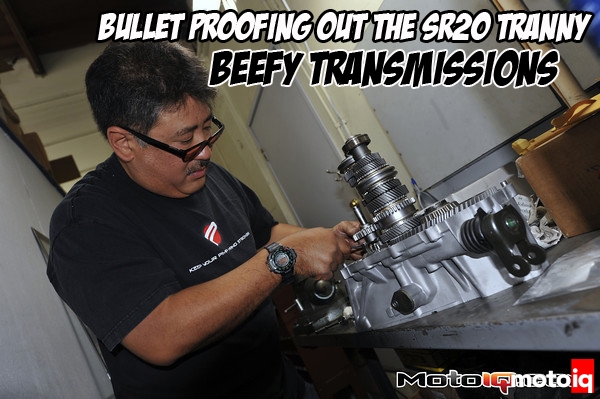,
For turbocharged motors, and more heavily modified engines more must be done, involving going inside the transmission. The first issue is the weak case. The transmission case cracks in the bellhousing side in the ribbed area near the axle hole. The weak area is fixed by cutting a small piece of aluminum to fill in the ribbed area bridging the axle hole and tig welding it in place. The welding should be done in skipped fashion to keep warping at a minimum. The bellhousing should be lightly surfaced after welding to prevent leaks.
 |
 |
| The Nissan Sentra SE-R tends to break the transmission case on the bellhousing near the axle hole. To prevent this a piece of aluminum is cut and tig welded to this area. After welding the case, it is resurfaced. Some have filled this area with JB weld with good results as well. |
The next series of tricks greatly help a Nissan FWD transmission but they can be done to help strengthen any transmission and are a good idea no mater what sort of car you drive. These steps need to be done in the following order for them to work correctly. Deburring the gears is the first step. Deburring is a light polishing of the gear tooth tops and sides. The polishing removes stress risers, sharp areas of stress concentration where cracks can form. The idea is not to round off the gear teeth but to break the sharp machined edges and give them a light polish. This also reduces the chances of the teeth digging into each other and causing damage that can cause the teeth to fail. A bench grinder with a scotchbrite red or green wheel works really well for this task.
 |
| A scotchbrite wheel is used to polish the tops and side edges of the gear teeth. This gets rid of stress risers on the teeth and helps prevent the teeth from digging into each other causing failure. |
After deburring, the gears should be treated to help improve fatigue strength. The gears should first be cryogenically treated to stress relieve them and convert austenite (a softer phase of steel crystalline structure) within the steel of the gears to the harder crystalline structure martensite. Cryogenic treatment involves cooling the parts to the temperature of liquid nitrogen then warming them to close to the tempering temperature which is around 350 degrees several times over about 72 hours. Cryogenic treatment generally can improve the fatigue strength of steel gears by over 100%. Cryo treatment is relatively inexpensive, usually the gears and shafts of a transmission cost around $100 to process.
After cryogenic treatment the gears should be shotpeened by a special two step process intended for hardened steel. Shotpeening is the bombardment of the surface of the steel with hard steel shot at high velocities. This refines the grain of the surface of the metal to a depth of around 2-3 thousands of an inch and imparts a compressive stress on the surface. This creates a skin on the surface of the part in which cracks have a hard time developing. Shotpeening can improve the fatigue strength of a steel part over 100%. The stock gears are nitrided, a process that leaves a hard wear resistant skin on the surface of the gear.
 |
| Shotpeening leaves a pebbly texture on the gear teeth. In addition to strengthening the parts, the texture helps retain a protective film of oil on the gear face. |
You should use a shotpeening service that can shotpeen to Mil-Std-13165c. AFCO, our shot peener typically uses hard steel shot in the range of Rockwell 55-65 C scale, mostly size 230 but sometimes size 330 to treat our parts. Usually, the Almen intensity is from .012 to .020 depending on the shot size and material. We let them decide what is best for our application.




15 comments
What would you do for a VX transmission going behind a turbo’d engine? Any other recommendations for the project would be welcomed
It depends, you can use these tricks to make the stock transmission last longer, mean I could say get a Quaife dogbox or a ppg gearset but I need to know about your budget and end use.
The amsoil severe gear 250 oil doesn’t effect the synchros? I was going to get the synchro mesh one which is 75 90 weight but I’m running about 300wheel in a 70 series p11 tranny. Rather get the heavier oil. I’ve used shock proof heavy gear oil forever but wanted to use amsoil because I’ve heard good things. Let me know. Thanks
Its almost like who cares if it affects the synchros or not because this transmission is so fragile. I have been running this gear oil in my race car for years with no damage to the synchros so far. The transmission has not blown up either!
Hi, I built a trans for the Grand Prix of Lemons in NZ, it has a PAR syncro gearset
We have a U13 Blobbird with tuned GTIR engine and trans, we had to lengthen the driveshafts about 20mm each to fit it
We lasted about 6hrs before the stock 3-4 selector broke, PAR and PPG are out of stock, 10 days wait for PAR. The gearset looks stressed on 2nd gear and has worn the teeth, plus what looks like slight breaking through the hardening in the centreline of each tooth on the drive side
We started with GL5 oil and changed to GL4 Castrol 5 speed to try and help the 3-4 syncro, it spat the pusher springs out in the end.
What should I do to this thing, a later box? Ours has double syncro on 2nd and it works great, and looks like double syncro on 5th, but the book says its got a cone for rev which I doubt as rev is on a sliding idler
I have used redline shockproof oil in my Rocket 3 BSA gearbox and our rally Capri 9″ diff, but wondered if it would upset the syncro engagement on this thing
Regards
Nelson
I have used Shockproof heavy on Syncro boxes for years with no ill effect. It works pretty well for keeping weak gearboxes together longer.
Can WPC work on the metal portion of clutch packs in an automatic transmission such as a TH-350?
yes
What company do you recommend to WPC treat gears? I was thinking about cryo treating and then WPC treating after.
CTP cryogenics has a treatment center in the same building as WPC.
Need gearbox parts
Hi Mike,
Just curious when it comes to WPC treatment of gears, shafts etc, do you have to dismantle everything and these parts get individual treatment or you leave it as? just as per your pics which show two gearbox shafts that have the gears on them?
thank you
Yes you do.
Shot peening definitely induced a major roughness. People are blasting the teeth face directly?
Yes